Space Weather Observations, Alerts, and Forecast
3-day Solar-Geophysical Forecast
Product: 3-Day Forecast
- Issued: 2026 Jan 21 0030 UTC
Prepared by the U.S. Dept. of Commerce, NOAA, Space Weather Prediction Center.
Geomagnetic Activity Observation and Forecast
The greatest observed 3 hr Kp over the past 24 hours was 8 (NOAA Scale G4). The greatest expected 3 hr Kp for Jan 21-Jan 23 2026 is 6.67 (NOAA Scale G3).
| Jan 21 | Jan 22 | Jan 23 | |
|---|---|---|---|
| 00-03UT | 6.67 (G3) | 4.00 | 2.67 |
| 03-06UT | 6.67 (G3) | 3.33 | 2.67 |
| 06-09UT | 5.67 (G2) | 3.00 | 2.33 |
| 09-12UT | 5.67 (G2) | 2.67 | 2.33 |
| 12-15UT | 4.67 (G1) | 3.00 | 2.33 |
| 15-18UT | 4.67 (G1) | 3.00 | 2.33 |
| 18-21UT | 3.67 | 3.33 | 2.33 |
| 21-00UT | 3.67 | 3.67 | 2.00 |
Rationale: G1-G3 (Minor-Strong) geomagnetic storms are anticipated on 20-21 Jan due to continuing CH HSS influence and the passage of a halo CME that arrived late on 19 Jan.
Solar Radiation Activity Observation and Forecast
Solar radiation, as observed by NOAA GOES-18 over the past 24 hours, was above S-scale storm level thresholds.
| Jan 21 | Jan 22 | Jan 23 | |
|---|---|---|---|
| S1 or greater | 99% | 45% | 15% |
Rationale: S1 (Minor) or greater solar radiation storms are expected to continue through 21 Jan, with the possibility of another crossing or slow decay keeping 22-23 Jan probabilities elevated.
Radio Blackout Activity and Forecast
No radio blackouts were observed over the past 24 hours.
| Jan 21 | Jan 22 | Jan 23 | |
|---|---|---|---|
| R1-R2 | 60% | 60% | 60% |
| R3 or greater | 15% | 15% | 15% |
Rationale: R1-R2 (Minor-Moderate) radio blackouts are likely, with a slight chance for R3 (Strong) events, on 21-23 Jan.
Real Time Images of the Sun
SOHO EIT 304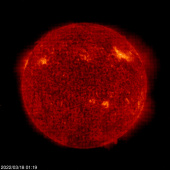
|
SOHO EIT 284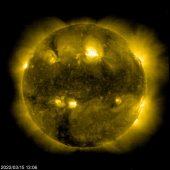
|
Mauna Loa Coronal Intensity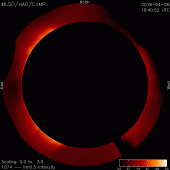
|
The sun is constantly monitored for sun spots and coronal mass ejections. EIT (Extreme ultraviolet Imaging Telescope) images the solar atmosphere at several wavelengths, and therefore, shows solar material at different temperatures. In the images taken at 304 Angstrom the bright material is at 60,000 to 80,000 degrees Kelvin. In those taken at 171 Angstrom, at 1 million degrees. 195 Angstrom images correspond to about 1.5 million Kelvin, 284 Angstrom to 2 million degrees. The hotter the temperature, the higher you look in the solar atmosphere. COMP CORONAL INTENSITY The COronal Multi-channel Polarimeter (CoMP) observes the Fe-XIII emission line at 1074.7 nm to measure the coronal magnetic field and obtain plasma density and motion in the low corona from ~1.03 to 1.5 solar radii.
Real Time Solar X-ray and Solar Wind
Latest LASCO Solar Corona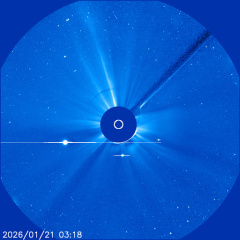
Large Angle and Spectrometric Coronagraph (LASCO). |
Real-Time Solar Wind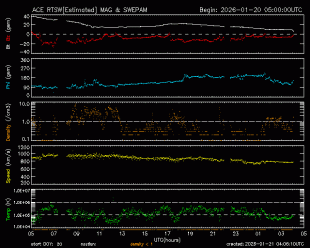
Real-Time Solar Wind data broadcast from NASA's ACE satellite. |
Space Weather Overview These plots show the current Space Weather Overview. |
Auroral Activity Extrapolated from NOAA POES
Northern Hemi Auroral Map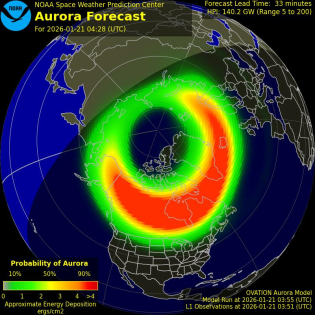
|
Southern Hemi Auroral Map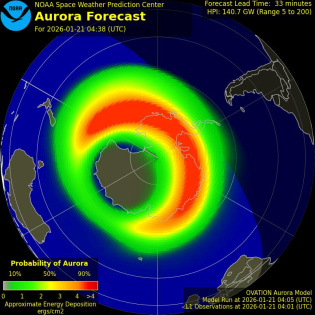
|
This is a short-term forecast of the location and intensity of the aurora. This product is based on the OVATION model and provides a 30 to 90 minute forecast of the location and intensity of the aurora. The forecast lead time is the time it takes for the solar wind to travel from the L1 observation point to Earth.
The two maps show the North and South poles of Earth respectively. The brightness and location of the aurora is typically shown as a green oval centered on Earths magnetic pole. The green ovals turn red when the aurora is forecasted to be more intense. The sunlit side of Earth is indicated by the lighter blue of the ocean and the lighter color of the continents. Aurora can often be observed somewhere on Earth from just after sunset or just before sunrise. The aurora is not visible during daylight hours. The aurora does not need to be directly overhead but can be observed from as much as a 1000 km away when the aurora is bright and if conditions are right. The aurora is an indicator of the current geomagnetic storm conditions and provides situational awareness for a number of technologies. The aurora directly impacts HF radio communication and GPS/GNSS satellite navigation. It is closely related to the ground induced currents that impact electric power transition. For many people, the aurora is a beautiful nighttime phenomenon that is worth traveling to arctic regions just to observe. It is the only way for most people to actually experience space weather. In 2020, NOAA SWPC implemented the new version of the OVATION Prime model into operations. This version has been dubbed OVATION 2020. The Auroral Forecast product is based on the OVATION Prime model developed by P. Newell at the Johns Hopkins, Applied Physics Laboratory.